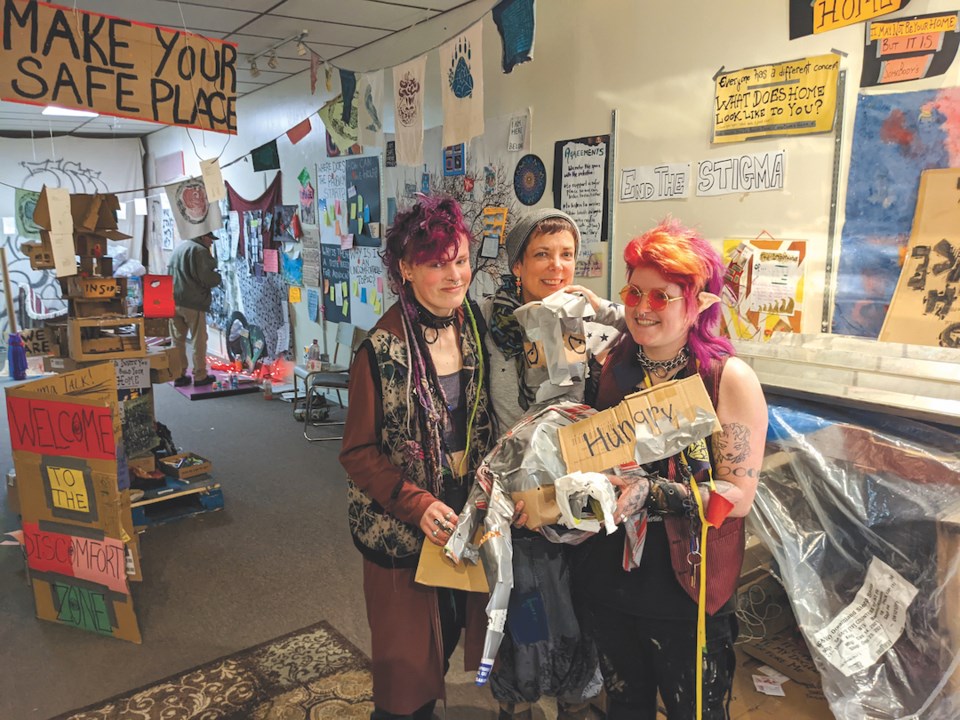“Welcome to the Discomfort Zone,” a giant card greeted visitors at the entrance to Deer Crossing the Art Farm’s Inside Outside display at Sunnycrest Mall.
The pop-up art project built by people with lived experiences of homelessness welcomed passerby to the space filled floor-to-ceiling with art pieces, dioramas, information boards and more. It closed March 25.
The display was an effort to challenge stereotypes and stigma, and build empathy within the community. It was funded by the provincial and federal governments' “Strengthening Communities Services" program and awarded by Town of Gibsons as a community engagement initiative on the housing crisis.
Deer Crossing the Art Farm had done community engaged art projects at the mall before, so they approached Sunnycrest late last year to see if there was a space available for such a project.
In February, organizers invited people with lived experience of homelessness or who are affected by homelessness, to come and share – also paying them an honorarium.
“A lot of people reached out and wanted to be a part of it. But a lot of people couldn’t show up because of their daily life just existing,” said Deer Crossing the Art Farm’s community engaged arts coordinator Sandy Buck. “It was tricky.”
The people who did come, created the space.
“It wasn’t just sitting down and talking about it, it was sitting down and making art and using their hands and sharing.”
“We use creative expression to discuss a really hard topic,” said Buck. “It’s different for every person.”
Elphi Sage and Shanese Flewelling-Veitch, in particular created a great deal of the work. “It was really loose,” said Sage, “People were invited to share their stories and their experiences and feel safe and express themselves through art.”
“We’re not trying to fit into a box of guidelines,” she explained. “Just let yourself express and how that develops is beautiful.”
Then, in March, the Inside Outside project threw open the doors to the public to wander through the maze of displays articulating experiences of homelessness.
Sage wants to see more of these spaces, where people can be safe to express themselves and where people can confront rampant stigma.
“A lot of people whose blanket answer for someone living on the street is get a job, they don’t understand how many resources you need. You need a safe place. You need clean clothes. You need somewhere to shower and preferably somewhere safe to sleep and reliable so you can get [to work] on time.
“You have no idea how hard it is to actually get back up unless you have all these resources to help you.”
Many of Sage’s projects are based around ending stigma (though Sage says this is the first intense advocacy in this way, it’s always been a passion). “That is what we view homelessness as and the idea the media tries to paint for us of what that face should look like.”
One of Sage’s installations was of a few dozen photos of smiling faces. “I reached out to my community, and they’re all attractive, smiling people.
“They’re people who are part of your community, who you don’t see as disgusting, aggressive, scary.”
“It’s changing that stigma and putting an end to it, so more people are on board with affordable housing,” said Sage. “They have all that fear based around it. They’re scared of it. They’re scared of the idea of ‘these people’ being in their neighbourhood.”
The response was heartening for Sage, but also striking.
“I forget that people live in a world where they don’t realize how dire this issue is.
“How it’s people who look completely average – if you would say – that need these resources and need this help.
“It’s like waking up their minds and bringing that awareness, so that the people with the bank accounts and who are doing well in the status quo [can help].
“The ground people can only do so much with lived experience and information and sharing their words or their thoughts on the subject. We need people to come in and be like, ‘We want to help this – what can we do?’”
For where the project goes from here, Buck says they’re hoping for more spaces so the conversation can continue and they’ll be doing an installation at the mall with some information.



